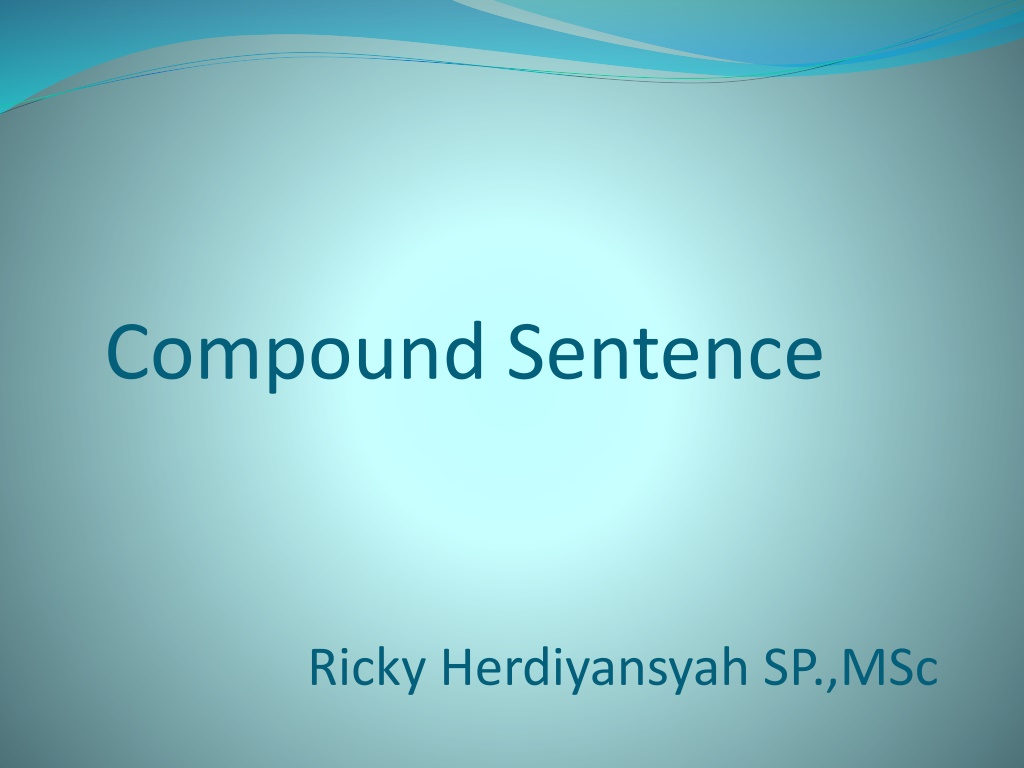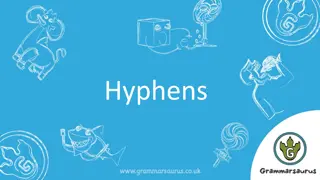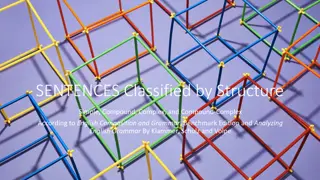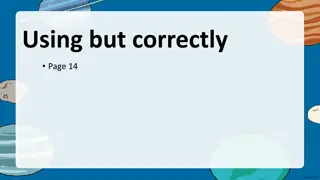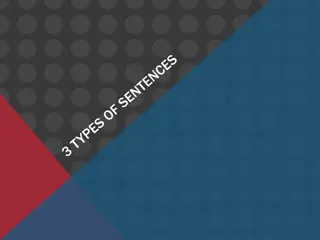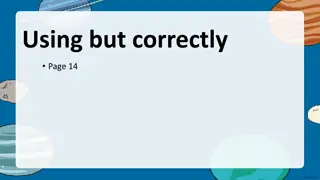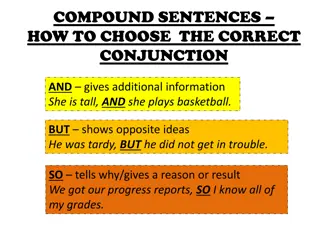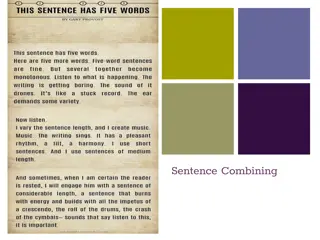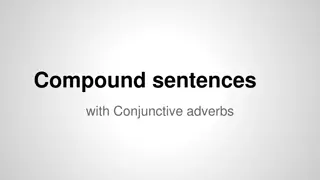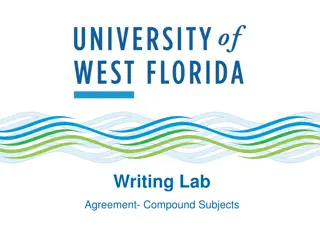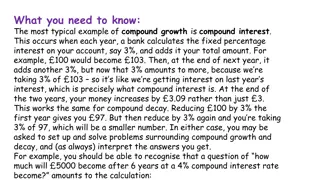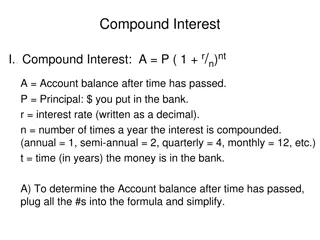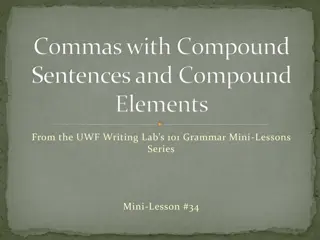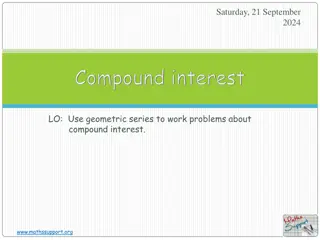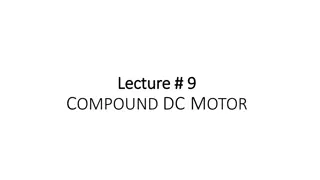Understanding Compound Sentences: Examples and Usage
A compound sentence is a group of words containing a subject and a predicate, expressing a complete idea. It can be brief or extended with qualifiers. Independent clauses are combined with coordinating conjunctions like "and," "but," or "or" to form compound sentences. Semicolons and transitional expressions can also be used to connect independent clauses. Transitional expressions can indicate time, emphasis, addition, or place. Explore how to construct and use compound sentences effectively with examples.
Download Presentation

Please find below an Image/Link to download the presentation.
The content on the website is provided AS IS for your information and personal use only. It may not be sold, licensed, or shared on other websites without obtaining consent from the author. Download presentation by click this link. If you encounter any issues during the download, it is possible that the publisher has removed the file from their server.
E N D
Presentation Transcript
Compound Sentence Ricky Herdiyansyah SP.,MSc
COMPOUND SENTENCE A sentence is a group of words that has a subject and a predicate (a verb) and expresses a complete idea. It can be very brief (consisting only subject predicate) or it can be longer (qualified by a qualifier or modifier). A combination of simple sentences (independent clauses) with or without modifiers is called a compound sentence. The independent clauses are connected by the coordinate conjunctions such as: and, but, or, nor, yet, for, so, etc. to form a compound sentence. Sometimes, a comma is used before the conjunction. Examples: The production of horticultural products is getting better, and exports of agricultural products are increased. The demand for agricultural products is high lately, so we must increase our productivity. Neither rambutan nor durians are sold in European market. 1. 2. 3.
Using semicolon and transitional expression to form a compound sentence Independent clauses (simple sentences) may also be joined together by using a semicolon with or without a transitional expression. When a transitional expression is used, it is placed in the between of a semicolon and a comma. Examples: Banana is one of popular tropical crops in Indonesia; besides, it is also an export horticultural commodity. Banana is one of popular tropical crops in Indonesia; it is also an export horticultural commodity. Rose can grow in a wide range of elevation; however, it requires low temperature to produce seeds. Rose can grow in a wide range of elevation;it requires low temperature to produce seeds.
Transitional expressions indicating time (waktu): Afterward (kemudian) Earlier (terdahulu) At the same time (sementara itu) In the mean time (sementara itu) Later (kemudian) Meanwhile (sementara itu) Simultaneously (secara serentak) Soon (kemudian, segera sesudahnya) Transitional expressions indicating emphasis (penekanan): Certainly (tentu) Indeed (sesungguhnya) In fact (sesungguhnya; nyatanya; pada kenyataannya) In short (pendek kata) In truth (sebenarnya; sesungguhnya) Of course (tentu saja; sudah barang tentu; pastilah)
Transitional expressions indicating addition (penambahan): Again (lagi-lagi) Also (juga) Besides (lagi pula; di samping itu) Equally important (sama pentingnya) Accordingly (sesuai dengan) Therefore (maka; oleh karena itu; oleh sebab itu) Thus (maka; jadi; dengan demikian) In addition (selanjutnya; selain itu; tambahan pula) Moreover (lagi pula) Further (kemudian) Furthermore (kemudian; selanjutnya) Transitional expressions indicating place (tempat): Beyond (di luar) Here (di sini) There (di sana) Opposite (di sebelah; di hadapan) To the left (di sebelah kiri) To the right (di sebelah kanan)
Transitional expression as an interrupter or parenthetic element in a sentence The words such as however, moreover, nevertheless, on the other hand, in fact, indeed, etc. are transitional expressions when they are placed in the between two (sometimes more) independent clauses to form a compound sentence. However, they may also function as interrupters when they are placed at the beginning, at the middle, or at the end of a sentence. As interrupters they are always separated by commas Consequently, a high concentration of plant growth regulators is required to induce callus proliferation. A high concentration of plant growth regulators, consequently, is required to induce callus proliferation. A high concentration of plant growth regulators is required to induce callus proliferation, consequently.
However, callus formation is an undesirable phenomenon in a micropropagation system because it may induce genetic variation within the resulted progenies. Callus formation, however, is an undesirable phenomena in a micropropagation system because it may induce genetic variation within the resulted progenies. (You can not say: Callus formation is an undesirable phenomena in a micropropagation system because it may induce genetic variation within the resulted progenies, however).
Assignment 1 Combine the pairs of the following independent clauses using semicolon and transitional expression given in the bracket. Make other changes as necessary and pay attention to your punctuation. Nipah flourishes in the swampy areas of many islands in Indonesia. Indonesians have not discovered the potential of this palm (however). Swampy areas stretch over large islands of Sumatra, Kalimantan and Irian. These areas are also found in islands such as Bangka and Belitung (in fact). Swampy regions are subjected to ocean tides. These areas can be reclaimed for agricultural purposes (simultaneously). Sugar and alcohol can be produced from nipah plant. Nipah plants have a great economic value (therefore). The leaves of nipah can be used for roofing materials. The jelly-like, sweet endosperm of young fruits is edible (in addition).
